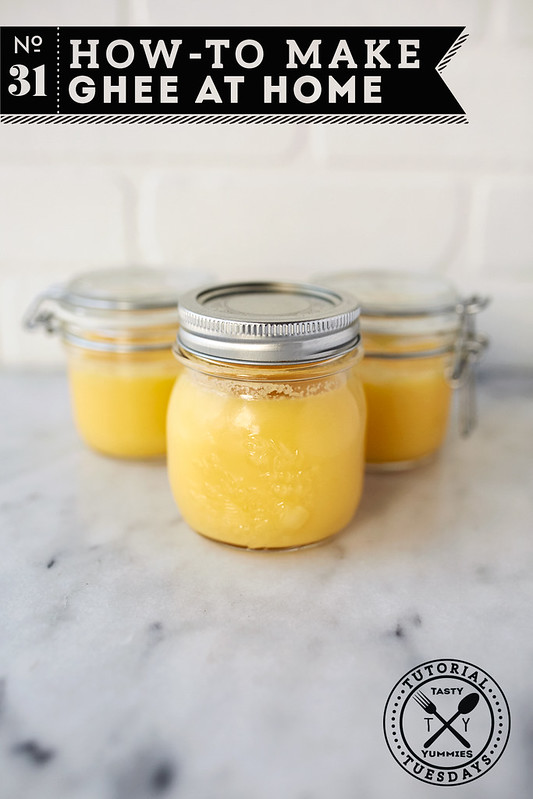-
How-to Make Ghee at Home
Ghee is a kitchen staple around here. For the longest time I was buying it, and I still do in a pinch, but as I discovered the cost efficiency and simplicity of making it at home, I have made this part of my DIY repertoire.
For those unfamiliar, ghee is a clarified butter, of sorts, that has been cooked down for some time, removing any moisture, milk solids and impurities. What remains is a pure and delicious butter oil, that has turned a beautiful golden color, it’s taste and flavor are slightly sweet and nutty. Ghee brings an aroma, taste and flavor a lot like butter, but even better. The difference between clarified butter and ghee is ghee’s lengthier cooking process, to remove all the moisture and the milk solids are browned in the fat and then strained out, bringing the slightly nutty taste. Ghee has a longer shelf life, due to all the moisture being removed.
Ghee is a wonderful option for those who are lactose or casein intolerant and want to enjoy the taste of butter. Ghee is also clearly a much better option than those scary hydrogenated oil-filled margarines and other highly processed vegan spreads. It does not burn, unless heated excessively, so it’s a wonderful option for stir fries, sautéing, frying, roasting, sauces, ettc. It’s also delicious as a spread, on toast, pancakes, scones, over rice and more. It can also be used on the body, as an oil for massage, as a base for healing herbal treatments, for burns, skin rashes, etc.

In India, ghee is a sacred and celebrated symbol of nourishment and healing, especially in daily rituals. It is also used in every day cooking. Ayurvedic physicians celebrate this liquid gold as being important to health and well-being, balance and vitality. If you don’t wish to make your own, ghee is usually found in the ethnic section of any big grocery store, in most Indian/South Asian stores or online.
Always make ghee with high-quality grass-fed organic butter. Cheap butter contains a lot of water and chemicals and it tends to burn faster. Due to the reduction and straining process, always start with 25% more butter than the amount of clarified butter desired. 1 pound of butter = approximately 1 1/2 cups ghee.
The Benefits of Choosing Ghee:
Rich Butter Taste without the Lactose or Casein. Made from butter ghee has the buttery flavor, but the milk solids have been removed, so if you are lactose or casein free, enjoy without issue.
Ghee has a high smoke point. 485ºF. You can cook and fry with ghee and it will not burn nor will it break down into free radicals, like so many other cooking oils can.
Ghee doesn’t spoil easily. Without the presence of milk fat and water, this makes ghee shelf stable. If you desire, it can be stored at room temperature rather then refrigeration. Ghee will last a couple months in an air-tight container at room temperature. If you aren’t sure if any moisture or milk solids remain, you can certainly play it safe and store in the fridge, to maximize it’s shelf life. That’s generally what I do.
Ghee is rich in fat soluable vitamins A D and E. If you have gluten sensitivity, leaky gut, IBS, Crohn’s or certain pancreatic disorders, you may have a problem absorbing vitamin A. By using ghee for cooking, and as a replacement for butter, you can increase your intake. Vitamin D can be made in the body, after exposure to sunlight, but obviously in the colder winter months is can be challenging for us to make enough. Ghee benefits the body by improving moisture and contains vitamin E, which is an antioxidant whose role is to repair damaged skin, balance hormones, improve vision and help to balance cholesterol. Fat-soluble vitamins are absorbed with fat and stored in the gastrointestinal tract — and they are essential to maintaining a healthy metabolism and various biochemical functions in the body. (1)
Ghee is also rich is K2 and Conjugated Linoleum Acid. Studies show K2 is better for building bones than calcium and proper levels of K2 can help fight tooth decay, bone loss and aid in the fight against the calcification of arteries. CJA is antioxidant with anti-viral properties, when sourced from grass-fed cows. Studies indicate that it may help to reduce tumors, lower cholesterol and high blood pressure, reduce inflammation, and actually lower body fat.(2)
Like coconut oil, ghee is rich is medium chain fatty acids, which are quickly absorbed directly to the liver and used as energy. This quick burn can actually lead to weight loss.
Ghee and butter are rich in butyric acid, a short chain fatty acid great for protection against fungal infections and aids in colon health. It’s been shown to support healthy insulin levels, is an anti-inflammatory, and may be helpful for individuals suffering from IBS, Crohn’s disease and ulcerative colitis. (3)
Ghee Reduces Inflammation. Ghee’s levels of butyrate play a role in reducing inflammation in the digestive tract and throughout the body. In Ayurvedic practice, ghee benefits the body by creating a more alkaline system that overall reduces inflammation by reducing the leukotriene secretion and reducing prostaglandin in the body(4)








